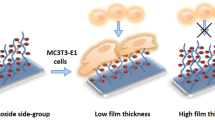Abstract
In the last decades, polymer brush coatings have proven to be excellent anti-fouling materials by preventing protein adhesion. When using this property to restrict cell growth laterally in cell culture, it is crucial to ensure that other cell functions remain unaffected. The present study therefore examines MC3T3-E1 cell growth and morphology on patterned PSBMA brush substrates and probes their proliferation potential at mRNA level. The osteoblastic cells display a more elongated morphology than cells on the control substrates, but show no sign of elevated levels of the apoptosis marker p53 or diminished levels of Ki-67 or H4, which serve as indicators of proliferation. Therefore, patterned polymer brushes do not seem to influence cells in their proliferation state and are suitable cell culture substrates. Nevertheless, the use of polymer brush surfaces in long-term cell culture was found to be limited by their instability in cell culture medium.




Similar content being viewed by others
References
Iwata R, Suk-In P, Hoven VP, Takahara A, Akiyoshi K, Iwasaki Y. Control of nanobiointerfaces generated from well-defined biomimetic polymer brushes for protein and cell manipulation. Biomacromolecules 2004; 5:2308–14.
Raynor JE, Capadona JR, Collard DM, Petrie TA, Garca AJ. Polymer brushes and self-assembled monolayers: versatile platforms to control cell adhesion to biomaterials (review). Biointerphases 2009; 4:FA3–FA16.
Kasemo B. Biological surface science. Surf Sci. 2002; 500:656–77.
Senaratne W, Andruzzi L, Ober CK. Reviews: self-assembled monolayers and polymer brushes in biotechnology: current applications and future perspectives. Biomacromolecules 2005; 6:2427–2448.
de las Heras Alarcn C, Farhan T, Osborne VL, Huck WTS, Alexander C. Bioadhesion at micro-patterned stimuli-responsive polymer brushes. J Mater Chem. 2005; 15:2089–94.
Zhou F, Huck WTS. Surface grafted polymer brushes as ideal building blocks for "smart" surfaces. Phys Chem Chem Phys. 2006; 8:3815–23.
Zhang Z, Chen S, Chang Y, Jiang S. Surface grafted sulfobetaine polymers via atom transfer radical polymerization as superlow fouling coatings. J Phys Chem B. 2006; 110:10799–804
Chang Y, Chen S, Zhang Z, Jiang S. Highly protein-resistant coatings from well-defined diblock copolymers containing sulfobetaines. Langmuir 2006; 22:2222–6.
Cheng G, Zhang Z, Chen S, Bryers JD, Jiang S. Inhibition of bacterial adhesion and biofilm formation on zwitterionic surfaces. Biomaterials 2007;28:4192–9.
Singh N, Cui X, Boland T, Husson SM. The role of independently variable grafting density and layer thickness of polymer nanolayers on peptide adsorption and cell adhesion. Biomaterials 2007; 28:763–71.
Sofia SJ, Premnath V, Merrill EW. Poly(ethylene oxide) grafted to silicon surfaces: grafting density and protein adsorption. Macromolecules 1998; 31:5059–70.
Mei Y, Wu T, Xu C, Langenbach KJ, Elliot JT, Vogt BD, Beers KL, Amis EJ, Washburn NR. Tuning cell adhesion on gradient poly(2-hydroxyethyl methacrylate)-grafted surfaces. Langmuir 2005; 21:12309–14.
McPherson T, Kidane A, Szleifer I, Park K. Prevention of protein adsorption by tethered poly(ethylene oxide) layers: experiments and single-chain mean-field analysis. Langmuir 1998; 14:176–86.
Tugulu S, Harms M, Fricke M, Volkmer D, Klok H-A. Polymer brushes as ionotropic matrices for the directed fabrication of microstructured calcite thin films. Angew Chem Int Ed. 2006; 45:7458–61.
Maeng IS, Park JW. Formation of a rectangular poly(methyl methacrylate) micropattern onto a polystyrene brush with use of atrp and electron beam irradiation. Langmuir 2003; 19:9973–6.
Shah RR, Merreceyes D, Husemann M, Rees I, Abbot NL, Hawker CJ, Hedrick JL. Using atom transfer radical polymerization to amplify monolayers of initiator patterned by microcontact printing into polymer brushes for pattern transfer. Macromolecules 2000; 33:597–5.
Letsche SA, Steinbach AM, Pluntke M, Marti O, Ignatius A, Volkmer D. Usage of polymer brushes as substrates of bone cells. Front Mater Sci China. 2009; 3:132–44.
Tomlinson MR, Bhat RR, Genzer J. Orthogonal polymer brush gradients: formation and applications. Polym Prepr. 2005; 46:44–5.
Tugulu S, Arnold A, Sielaff I, Johnsson K, Klok H-A. Protein-functionalized polymer brushes. Biomacromolecules 2005; 6:1602–7.
Azzaroni O, Brown AA, Huck WTS. UCST wetting transitions of polyzwitterionic brushes driven by self-association. Angew Chem Int Ed. 2006; 45:1770–4.
Livak KJ, Schmittgen TD. Analysis of relative gene expression data using real-time quantitative PCR and the \(2^{-\Updelta \Updelta C_T}\) method. Methods 2001; 25:402–8.
Amaral JD, Xavier JM, Steer CJ, Rodrigues CM. The role of p53 in apoptosis. Discov Med. 2010; 45:145–52.
Winking H, Gerdes J, Traut W. Expression of the proliferation marker Ki-67 during early mouse development. Cytogenet Genome Res. 2004; 105:251–6.
Choi J-Y, Lee B-H, Song K-B, Park R-W, Kim I-S, Sohn K-Y, Jo J-S, Ryoo H-M. Expression patterns of bone-related proteins during osteoblastic differentiation in MC3T3-E1 cells. J Cell Biochem. 1996; 61:609–18.
Mendelsohn JD, Yang SY, Hiller JA, Hochbaum AI, Rubner MF. Rational design of cytophilic and cytophobic polyelectrolyte multilayer thin films. Biomacromolecules 2003; 4:96–106.
Mar-Buy N, O’Shaughnessy S, Colominas C, Semino CE, Gleason KK, Borrs S. Functionalized, swellable hydrogel layers as a platform for cell studies. Adv Funct Mater. 2009; 19:1276–86.
Harris BP, Kutty JK, Fritz EW, Webb CK, Burg KJL, Metters AT. Photopattern polymer brushes promoting cell adhesion gradients. Langmuir 2006; 22:4467–71.
Tugulu S, Klok H-An. Stability and non-fouling properties of poly(poly(ethylene glycol) methacrylate) brushes under cell culture conditions. Biomacromolecules 2008; 9:906–12.
Acknowledgements
This study was supported by the Landesstiftung Baden-Württemberg. Annina Steinbach gratefully appreciates the scholarship of the Landesgraduiertenförderung Baden-Württemberg.
Author information
Authors and Affiliations
Corresponding author
Rights and permissions
About this article
Cite this article
Steinbach, A., Tautzenberger, A., Ignatius, A. et al. Coatings from micropatterned sulfobetaine polymer brushes as substrates for MC3T3-E1 cells. J Mater Sci: Mater Med 23, 573–579 (2012). https://doi.org/10.1007/s10856-011-4525-y
Received:
Accepted:
Published:
Issue Date:
DOI: https://doi.org/10.1007/s10856-011-4525-y




